When it comes to the Dynafit Radical 2.0 the current version is almost a no-brainer decision for anyone earning turns who wants to save weight without sacrificing frills like brakes and easy to flip climbing posts. The only feature you need consider is the toe that rotates a few degrees in downhill mode to add some elasticity to a pin system known for pre-release. The question is do you need the extra elasticity and is it worth the cost? Cost is less about price and more about the consequences of that rotation. Below, a review of the undisputed benefits.
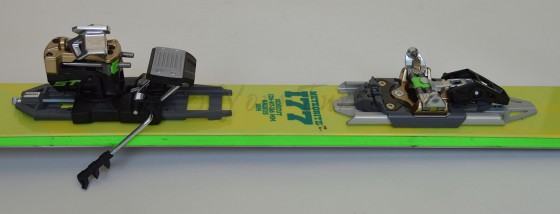
Dynafit’s Radical 2.0 on a rental frame. Erase the rental frame and you have the culmination of 30 years fiddling with the Dynafit concept. TUV Certified for reliable release.
The Radical 2.0 is the culmination of all that Dynafit has learned in pioneering their revolutionary low tech binding system which, to those who have attempted to copy it have learned, it is anything but low-tech. In fact, the simplicity of Dynafit’s tech system is due to extra precision in the control systems required to manufacture it. This yields a binding that, within the inherent limits of a 2-pin tech binding, can be relied upon when you’re far from help. And in the alpine world of reliable release, the Radical 2.0 has achieved the coveted TUV certification for this ability.
Da Heel
Though the silver-haired crowd laments the ability to switch modes without exiting the binding, a move that was possible with the classic TLT or Vertical bindings, this is offset by climbing posts that are much easier to engage. Ninety percent of the time if you’re switching modes you’re putting your skins on so exiting the binding is barely an inconvenience. However, experienced backcountry skiers know that for the remaining ten percent of the time, when you have to cross a big flat zone between pitches, you don’t want to have to stop and step out of your binding to free your heel. Free heeled tele skiers can steal the momentum at times like this, but with Dynafit you can dust ’em on the next climb.To free the heel for touring rotate it clockwise about 90 degrees. With the heel unit cocked to the side the brakes will stay retracted once you push the brake pad down flat. Reverting to downhill mode simply rotate in reverse, counter-clockwise (not all the way around as in earlier Dynafit models).
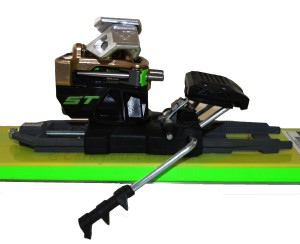
Rad 2 heel ready for turns. Note the beefed up base and top plate compared to the first gen Radical.
The first gen Radical 1.0 had some inherent weaknesses that have all been addressed with version 2.0. The housing has struts strategically placed around the base to create a wider, more stable platform. The top plate and the associated climbing posts have been beefed up relative to the inaugural version so they won’t die prematurely.
The climbing posts provide two heights, 38mm and 60mm, or approximately 7° and 13° climbing angles. Steep skinners lament the lack of a true high post (> 15 degrees), and meanderthals the opposite. The low post is made wider so it can be lifted by itself. If you grew up switching posts by rotating the classic Dynafit heel and even got good at it you will be hard pressed to not appreciate how easily these posts can be flipped up or down. This feature alone may be sufficient to motivate an upgrade.
Da Toe
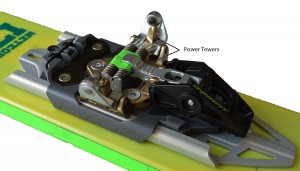
Radical 2.0 toe has power towers for alignment. Combined with rotation movement it helps reduce pre-release.
That extra elasticity in a tech binding is great, but it means you need to be more careful getting in to the binding. For starters, because of that ability to rotate, the toe may not be perpendicular to the length of the ski as you would naturally expect. In fact, chances are high that while lowering your boot to click in at the heel you’ll probably twist your foot a bit and the heel insert will be offset from the spring bars on the heel. With non-rotating toes you can reliably just slam the heel, not so with the Radical’s rotating toe. Before you slam down, make sure the slots on the heel of your boot DO align with the pins on the binding heel by lowering it slowly and visually checking alignment. If it looks good step down firmly to finish the job.
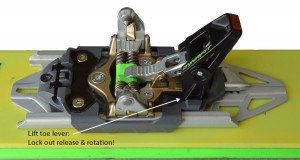
With the toe lever lifted you lock out the ability for the toe jaws/arms to open up AND the ability to rotate. Locking it makes alignment of the heel for downhill reliable but don’t forget to unlock it when you’re ready to turn.
Conclusion
From the standpoint of user friendliness the Dynafit Radical is an easy to use binding; the climbing posts are a delight to flip up or down, the ski brakes work as you would hope, and release is more reliable than ever for a tech binding. The weight may not be race caliber, but anyone looking at the Radical 2.0 isn’t using this as a race tool except for the inevitable tendency to want to log as many vertical feet in the backcountry as possible. If you’re in that mindset you’ll save more weight with judicious selection of boots and skis compared to the savings you make by getting a still lighter Dynafit binding. The other benefit of the Radical 2.0 is that it is stout enough to put up with in-bounds abuse, so it’s a good quiver of one binding. The rotational movement of the toe means you need to be more careful getting in to the binding, so it isn’t easier to get in to, but it certainly isn’t hard either, certainly not compared to older legacy Dynafiddle bindings.
Dynafit
Radical FT 2.0
MSRP: $650
Weight/binding: 630 g (22½ oz.)
Release Value range: 5-12
Ski brakewidths (mm): 105, 120, 135
Radical ST 2.0
MSRP: $550
Weight/binding: 599 g (21 oz.)
Release Value range: 4-10
Ski brakewidths (mm): 90, 105, 120, 130
© 2017

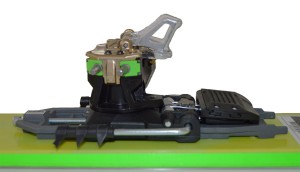
4 comments
1 ping
Skip to comment form
I demoed those bindings. I disliked them. The rotating toe means that you have to be extra careful how you lock the toe in a touring mode. Since it rotates just a smidge if you don’t crank on it like your life depended on it, it is super easy to release the brake or even rotate the heel into the ski mode all together locking your heel on the skin track.
Personally I much prefer the original Radicals and G3 ION going forward.
Are you saying when you lock the toe for touring a single click allows the toe to rotate – thus causing the heel to revert to downhill mode? Never experienced that since I always pull up at least 2-3 clicks.
Well, I was on a demo tour with a local shop and am used to the first gen Radicals. Clicked a couple of clicks and headed uphill… First the brake kept popping down. Then I got my heel locked in a ski mode. Took me a bit to figure out that it was my heel that accidentally rotated the back piece.
What’s a purpose of having multiple clicks if you always have to crank the thing all the way? Make it one good one and be done with it…
I’m planning to forego this 2.0 gimmickry. picked up another set of first gen bindings last season and that’ll probably hold me over for a decade or two… LOL
I’ve used this binding quite a bit. After the Verts, the rotating toe is a bit different when first stepping into the binding. I place the toe pins in the “cups” on my boots then pull the toe lock all the way up (2 or 3 clicks) as I slowly rotate the toe left and right to find the detent.
Once you’ve done this the boot heel will be aligned to stomp the heel and lock in the heel pins. Now return toe to “Ski” mode and you are ready to go skiing.
Much easier to do this way, then stomping the heel down repeatedly trying to line up notches in boot heel with heel pins.
Ski brakes are much more rigid than the ones that were on the Verts.
Thank you for the article.
Great blog that I enjoyed reading.